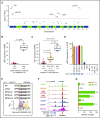Whole-genome noncoding sequence analysis in T-cell acute lymphoblastic leukemia identifies oncogene enhancer mutations
- PMID: 28408461
- PMCID: PMC5472902
- DOI: 10.1182/blood-2017-03-771162
Whole-genome noncoding sequence analysis in T-cell acute lymphoblastic leukemia identifies oncogene enhancer mutations
Abstract
Publisher's Note: There is an
Figures


Comment in
-
Novel oncogenic noncoding mutations in T-ALL.Blood. 2017 Jun 15;129(24):3140-3142. doi: 10.1182/blood-2017-04-773242. Blood. 2017. PMID: 28620102 No abstract available.
References
-
- Roberts KG, Mullighan CG. Genomics in acute lymphoblastic leukaemia: insights and treatment implications. Nat Rev Clin Oncol. 2015;12(6):344-357. - PubMed
-
- Belver L, Ferrando A. The genetics and mechanisms of T cell acute lymphoblastic leukaemia. Nat Rev Cancer. 2016;16(8):494-507. - PubMed
-
- Aifantis I, Raetz E, Buonamici S. Molecular pathogenesis of T-cell leukaemia and lymphoma. Nat Rev Immunol. 2008;8(5):380-390. - PubMed
Publication types
MeSH terms
LinkOut - more resources
Full Text Sources
Other Literature Sources
Medical

